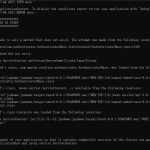Solr是一个独立的企业级搜索应用服务器,Solr是一个高性能,基于Lucene的全文搜索服务器。同时对其进行了扩展,提供了比Lucene更为丰富的查询语言,同时实现了可配置、可扩展并对查询性能进行了优化,并且提供了一个完善的功能管理界面,是一款非常优秀的全文搜索引擎。
来源:https://cwiki.apache.org/confluence/display/solr/Legacy+solr.xml+Configuration
Use solr.xml to configure your Solr core (a logical index and associated configuration files), or to configure multiple cores. You can find solr.xml in your Solr Home directory. The default solr.xml file looks like this:
<solr persistent="true"> <cores adminPath="/admin/cores" defaultCoreName="collection1" host="${host:}" hostPort="${jetty.port:}" hostContext="${hostContext:}" zkClientTimeout="${zkClientTimeout:15000}"> <core name="collection1" instanceDir="collection1" /> </cores></solr> |
For more information about core configuration and solr.xml, see http://wiki.apache.org/solr/CoreAdmin.
Using Multiple SolrCores
It is possible to segment Solr into multiple cores, each with its own configuration and indices. Cores may be dedicated to a single application or to very different ones, but all are administered through a common administration interface. You can create new Solr cores on the fly, shutdown cores, even replace one running core with another, all without ever stopping or restarting your servlet container.
Solr cores are configured by placing a file named solr.xml in your solr.home directory. A typical solr.xml looks like this:
<solr persistent="false"> <cores adminPath="/admin/cores" host="${host:}" hostPort="${jetty.port:}"> <core name="core0" instanceDir="core0" /> <core name="core1" instanceDir="core1" /> </cores></solr> |
This sets up two Solr cores, named "core0" and "core1", and names the directories (relative to the Solr installation path) which will store the configuration and data sub-directories.
| You can run Solr without configuring any cores. |
Solr.xml Parameters
The <solr> Element
There are several attributes that you can specify on <solr>, which is the root element of solr.xml.
| Attribute | Description |
|---|---|
| coreLoadThreads | Specifies the number of threads that will be assigned to load cores in parallel |
| persistent | Indicates that changes made through the API or admin UI should be saved back to this solr.xml. If not true, any runtime changes will be lost on the next Solr restart. The servlet container running Solr must have sufficient permissions to replace solr.xml (file delete and create), or errors will result. Any comments in solr.xml are not preserved when the file is updated. The default is true. |
| sharedLib | Specifies the path to a common library directory that will be shared across all cores. Any JAR files in this directory will be added to the search path for Solr plugins. This path is relative to the top-level container's Solr Home. |
| zkHost | In SolrCloud mode, the URL of the ZooKeeper host that Solr should use for cluster state information. |
| If you set the persistent attribute to true, be sure that the Web server has permission to replace the file. If the permissions are set incorrectly, the server will generate 500 errors and throw IOExceptions. Also, note that any comments in the solr.xml file will be lost when the file is overwritten. |
The <cores> Element
The <cores> element, which contains definitions for each Solr core, is a child of <solr> and accepts several attributes of its own.
| Attribute | Description |
|---|---|
| adminPath | This is the relative URL path to access the SolrCore administration pages. For example, a value of /admin/cores means that you can access the CoreAdminHandler with a URL that looks like this: http://localhost:8983/solr/admin/cores. If this attribute is not present, then SolrCore administration will not be possible. |
| host | The hostname Solr uses to access cores. |
| hostPort | The port Solr uses to access cores. In the default solr.xml file, this is set to ${jetty.port:}, which will use the Solr port defined in Jetty. |
| hostContext | The servlet context path. |
| zkClientTimeout | A timeout for connection to a ZooKeeper server. It is used with SolrCloud. |
| distribUpdateConnTimeout | Used to set the underlying "connTimeout" for intra-cluster updates. |
| distribUpdateSoTimeout | Used to set the underlying "socketTimeout" for intra-cluster updates |
| leaderVoteWait | When SolrCloud is starting up, how long each Solr node will wait for all known replicas for that share to be found before assuming that any nodes that haven't reported are down. |
| genericCoreNodeNames | If TRUE, node names are not based on the address of the node, but on a generic name that identifies the core. When a different machine takes over serving that core things will be much easier to understand. |
| managementPath | no-op at present. |
| defaultCoreName | The name of a core that will be used for requests that do not specify a core. |
| transientCacheSize | Defines how many cores with transient=true that can be loaded before swapping the least recently used core for a new core. |
| shareSchema | This attribute, when set to true, ensures that the multiple cores pointing to the same schema.xml will be referring to the same IndexSchema Object. Sharing the IndexSchema Object makes loading the core faster. If you use this feature, make sure that no core-specific property is used in your schema.xml. |
| adminHandler | If used, this attribute should be set to the FQN (Fully qualified name) of a class that inherits from CoreAdminHandler. For example, adminHandler="com.myorg.MyAdminHandler" would configure the custom admin handler (MyAdminHandler) to handle admin requests. If this attribute isn't set, Solr uses the default admin handler, org.apache.solr.handler.admin.CoreAdminHandler. For more information on this parameter, see the Solr Wiki at http://wiki.apache.org/solr/CoreAdmin#cores. |
The <logging> Element
There is at most one <logging> element for a Solr installation that defines various attributes for logging.
| Attribute | Description |
|---|---|
| class | The class to use for logging. The corresponding JAR file must be available to solr, perhaps through a <lib> directive in solrconfig.xml. |
| enabled | true/false - whether to enable logging or not. |
In addition, the <logging> element may have a child element <watcher> which may have the following attributes
| size | The number of log events that are buffered. |
| threshold | The logging level above which your particular logging implementation will record. For example when using log4j one might specify DEBUG or WARN or INFO etc. |
The <core> Element
There is one <core> element for each SolrCore you define. They are children of the <cores> element and each one accepts the following attributes.
| Attribute | Description |
|---|---|
| name | The name of the SolrCore. You'll use this name to reference the SolrCore when running commands with the CoreAdminHandler. |
| instanceDir | This relative path defines the Solr Home for the core. |
| config | The configuration file name for a given core. The default is solrconfig.xml. |
| schema | The schema file name for a given core. The default is schema.xml |
| dataDir | This relative path defines the Solr Home for the core. |
| properties | The name of the properties file for this core. The value can be an absolute pathname or a path relative to the value of instanceDir. |
| transient | If true, the core can be unloaded if Solr reaches the transientCacheSize. The default if not specified is false. Cores are unloaded in order of least recently used first. |
| loadOnStartup | If true, the default if it is not specified, the core will loaded when Solr starts. |
| coreNodeName | Added in Solr 4.2, this attributes allows naming a core. The name can then be used later if you need to replace a machine with a new one. By assigning the new machine the same coreNodeName as the old core, it will take over for the old SolrCore. |
| ulogDir | The absolute or relative directory for the update log for this core (SolrCloud) |
| shard | The shard to assign this core to (SolrCloud) |
| collection | The name of the collection this core is part of (SolrCloud) |
| roles | Future param for SolrCloud or a way for users to mark nodes for their own use. |
Properties in solr.xml
You can define properties in solr.xml that you may then reference in solrconfig.xml and schema.xml. Properties are name/value pairs. The scope of a property depends on which element it occurs within.
If a property is declared under <solr> but outside a <core> element, then it will have container scope and will be visible to all cores. In the example above, productname is such a property.
If a property declaration occurs within a <core> element, then its scope is limited to that core and it will not be visible to other cores. A property at core scope will override one of the same name declared at container scope.
<solr persistent="true" sharedLib="lib"> <property name="productname" value="Acme Online"/> <cores adminPath="/admin/cores"> <core name="core0" instanceDir="core0"> <property name="dataDir" value="/data/core0"/></core> <core name="core1" instanceDir="core1"/> </cores></solr> |
In addition to any properties you declare at the core level, there are several properties that Solr defines automatically for each core. These properties are described in the table below:
| Property | Description |
|---|---|
| solr.core.name | The core's name, as defined by the "name" attribute. |
| solr.core.instanceDir | The core's instance directory under which that its conf/ and data/ directories are located, derived from the core's instanceDir attribute. |
| solr.core.dataDir | The core's data directory, ${solr.core.instanceDir}/data by default. |
| solr.core.configName | The name of the core's configuration file, solrconfig.xml by default. |
| solr.core.schemaName | The name of the core's schema file, schema.xml by default. |
Any of the above properties can be referenced by name in schema.xml or solrconfig.xml.
When defining properties, you can assign a property a default value that will be used if another value isn't specified. For example:
<!-- Blank unless company.name variable is defined --><str name="foo">${company.name}</str><!-- "SearchCo MegaIndex" if company.name variable is not defined --><str name="bar">${some.variable.name:SearchCo MegaIndex}</str> |



